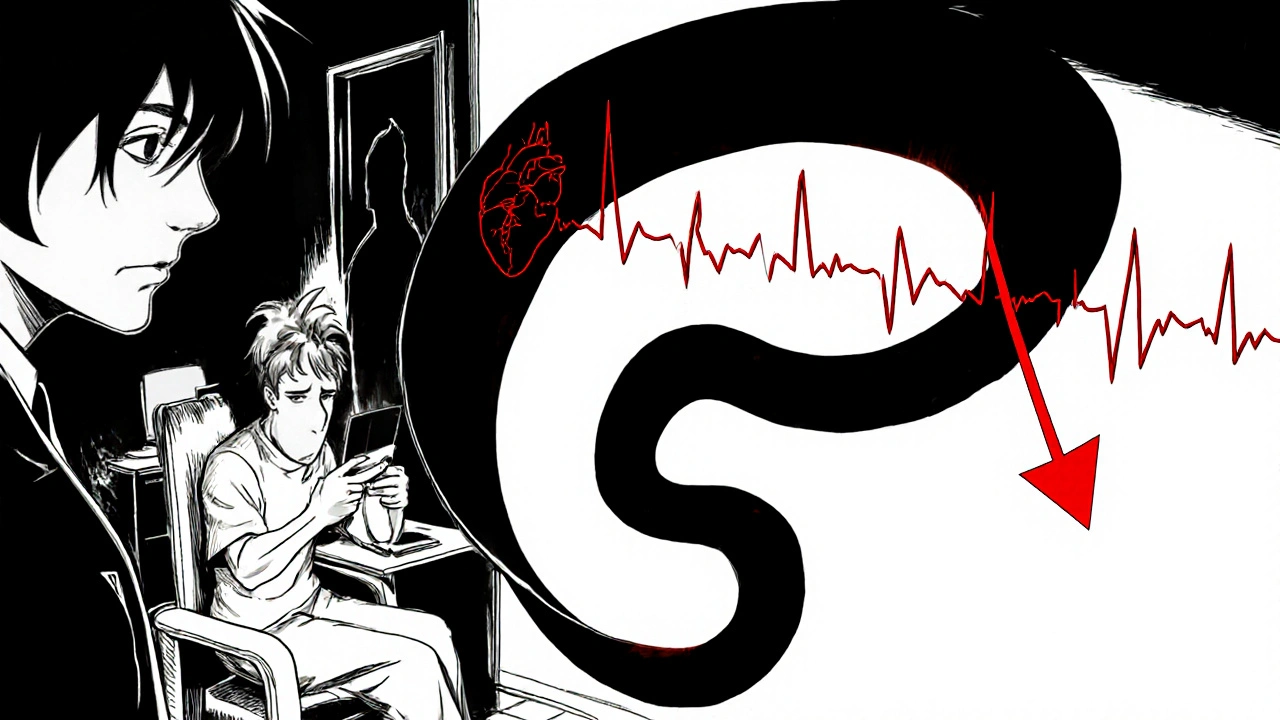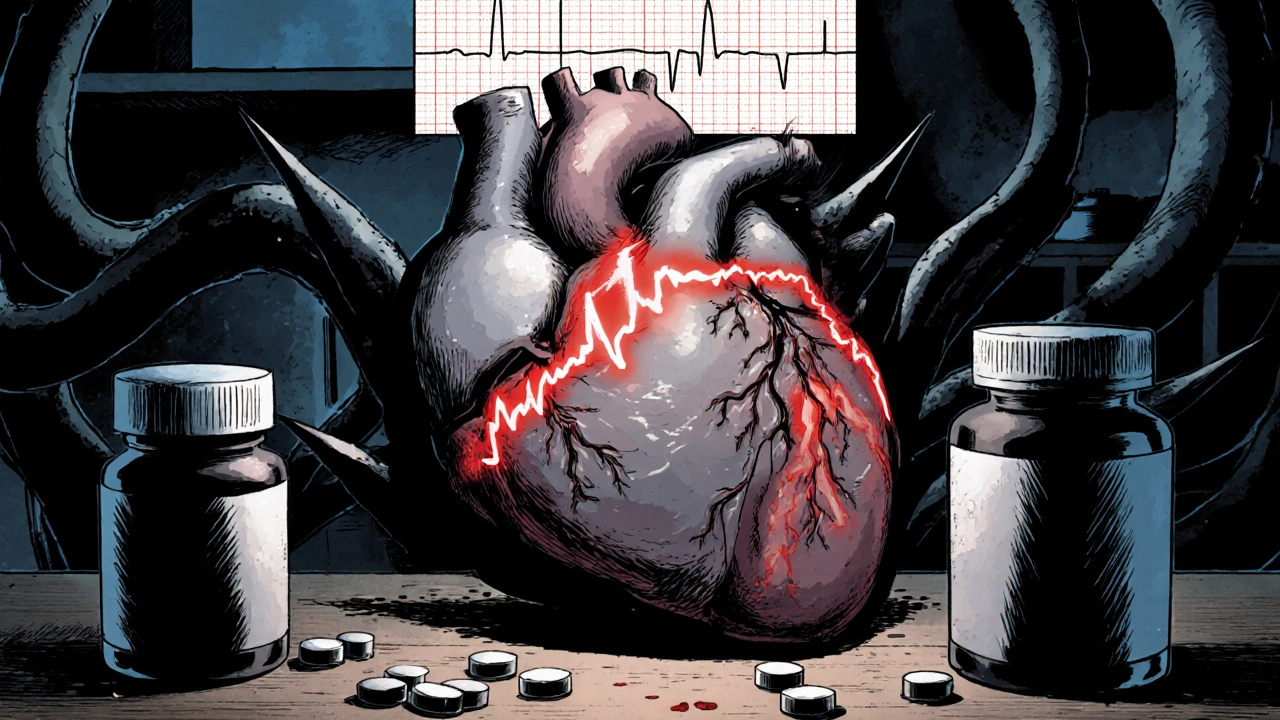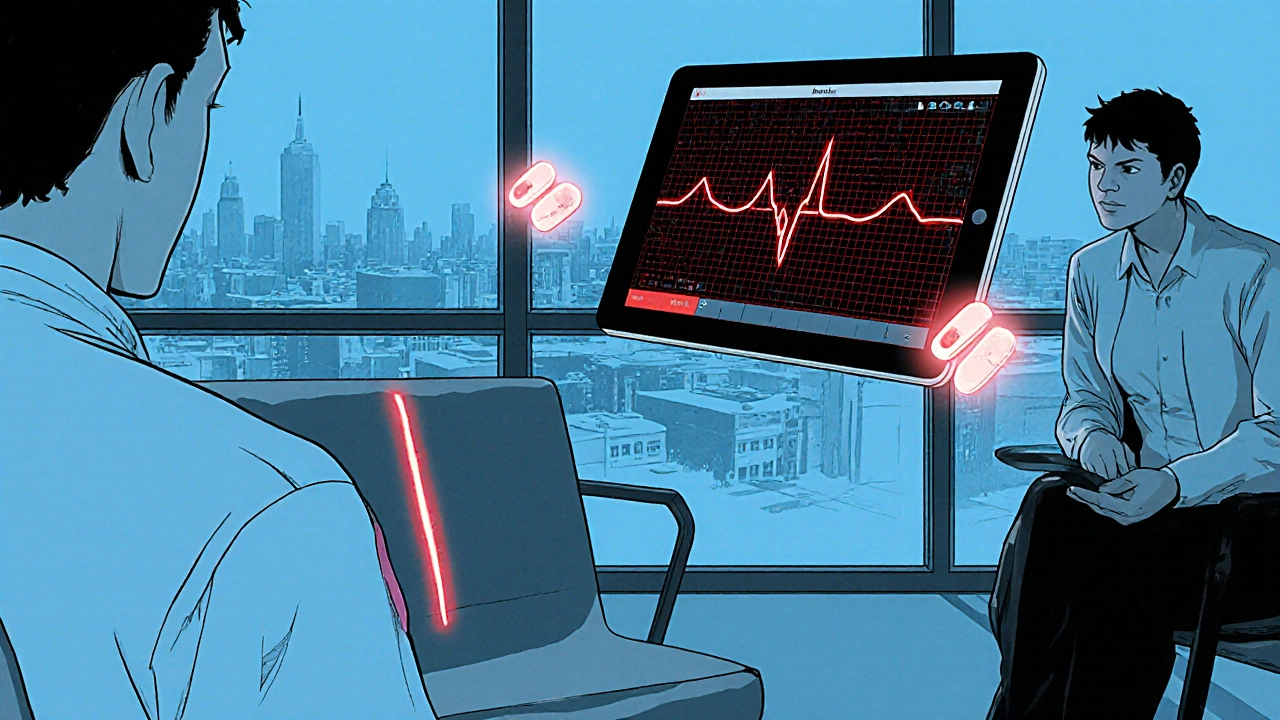
QT Prolongation Risk Calculator
Risk Assessment Tool
Quick Takeaways
- About 70% of commonly prescribed antipsychotics lengthen the QT interval, and the danger spikes when they’re paired with any other QT‑prolonging medication.
- High‑risk antipsychotics (thioridazine, ziprasidone, haloperidol) can increase sudden cardiac death risk up to 8‑fold; low‑risk options (aripiprazole, brexpiprazole) show no significant effect.
- Polypharmacy can raise QTc by 2‑5 × compared with monotherapy, often pushing values past the 500 ms danger threshold within 72 hours.
- Baseline ECG, weekly QTc checks for the first month, and aggressive electrolyte management cut torsades de pointes (TdP) risk by >60% in high‑risk groups.
- Digital ECG patches and risk‑calculator apps are becoming standard tools for out‑patient monitoring in 2025.
When a psychiatrist prescribes an antipsychotic, the conversation usually centers on efficacy, side‑effects like weight gain, and adherence. Cardiac safety, especially QT interval prolongation, often gets relegated to the back of the chart. Yet the numbers tell a different story. The 2023 FDA Drug Safety Communication documented 128 cases of torsades de pointes (TdP) linked to antipsychotic‑plus‑QT‑prolonging drug combos between 2010 and 2022. In plain English: mixing these meds can be a ticking time‑bomb for the heart.
QT prolongation is a cardiac electrical abnormality in which the heart’s repolarization phase exceeds normal limits-typically >450 ms in men and >460 ms in women. The extended interval creates a fertile ground for dangerous ventricular arrhythmias, most famously torsades de pointes. The problem isn’t new; French physician Dessertenne first described TdP in 1966, and the phenomenon re‑emerged in the 1960s when first‑generation antipsychotics entered the market.
Antipsychotics are a class of psychotropic drugs used primarily for schizophrenia, bipolar disorder, and severe depression. About 70% of these agents block the hERG potassium channel (human ether‑à‑go‑go‑related gene), the key regulator of cardiac repolarization. Blocking hERG delays the heart’s “reset” after each beat, stretching the QT interval.
How the QT Interval Is Measured
The QT interval runs from the start of the QRS complex to the end of the T wave on an ECG. Because heart rate varies, clinicians correct the raw QT using Bazett’s formula (QTc = QT/√RR). The International Conference on Harmonisation (2023) defines normal QTc as < 440 ms for men and < 460 ms for women; values above 500 ms carry a markedly higher TdP risk.
Intrinsic QT Risk of Individual Antipsychotics
Not all antipsychotics carry the same danger. Researchers rank them by hERG blockade potency (IC50). Lower IC50 means stronger block.
| Drug | Risk Category | hERG IC50 (μM) | Typical Daily Dose |
|---|---|---|---|
| Thioridazine | High | 0.04 | 50-800 mg |
| Ziprasidone | High | 0.13 | 20-80 mg |
| Haloperidol | High | 0.15 | 0.5-15 mg |
| Quetiapine | Moderate | 2.5 | 150-800 mg |
| Risperidone | Moderate | 3.1 | 0.5-8 mg |
| Olanzapine | Moderate | 4.2 | 5-20 mg |
| Aripiprazole | Low | 11.7 | 2-30 mg |
| Brexpiprazole | Low | 15.3 | 0.5-4 mg |
| Lurasidone | Low | 18.9 | 20-120 mg |
High‑risk agents like thioridazine have largely disappeared from US formularies (withdrawn in 2005) but still appear abroad. Low‑risk agents such as aripiprazole are gaining market share, now accounting for roughly 38% of new prescriptions.

When Another QT‑Prolonging Drug Joins the Party
Common co‑prescribed QT‑prolonging drugs include fluoroquinolone antibiotics (e.g., moxifloxacin, IC50 2.8 μM), antiarrhythmics (sotalol, IC50 0.08 μM), certain antiemetics (ondansetron), and some antidepressants (citalopram). The pharmacodynamic interaction follows a roughly linear concentration‑additive model: each added drug can push QTc up another 20‑30 ms.
A 2021 University of Pennsylvania model showed a 2.3‑ to 4.7‑fold increase in QTc when antipsychotics were combined with another QT‑prolonging agent, even when each drug was at a low therapeutic dose. In real‑world data, the JAMA Internal Medicine 2018 study found a 4.3‑fold higher TdP risk for antipsychotic‑plus‑antidepressant combos versus antipsychotic alone.
Clinical Evidence of Additive Arrhythmia Risk
Several large‑scale studies paint a clear picture:
- 2015 Taiwan NHIRD analysis: thioridazine users faced a 7.8‑fold increase in sudden cardiac death compared with non‑users.
- 2018 JAMA Internal Medicine: antipsychotic + antidepressant increased TdP risk 4.3× (95% CI 2.7‑6.8).
- 2022 University of Michigan meta‑analysis: antipsychotic + ondansetron raised QTc by an average of 38.7 ms versus 22.4 ms for monotherapy.
- FDA pharmacovigilance (2024): 78% of TdP cases occurred within 72 hours of starting a risky combination.
These numbers matter because a QTc >500 ms is associated with a 5.3‑fold increase in TdP, yet the absolute annual risk in psychiatric populations remains under 1 %-a figure that can be driven down further with proper monitoring.
Practical Monitoring Strategies
Guidelines from the American Heart Association (2023) and American Psychiatric Association (2025) converge on a simple algorithm:
- Obtain a baseline ECG within one week of initiating any high‑ or moderate‑risk antipsychotic.
- For high‑risk combos (antipsychotic + another QT‑prolonging drug), repeat ECG weekly for the first four weeks, then monthly.
- For moderate‑risk monotherapy, re‑check at 1 week, 4 weeks, and quarterly thereafter.
- Correct electrolyte abnormalities aggressively-maintain potassium >4.0 mmol/L and magnesium >2.0 mg/dL.
- Document any bradycardia (<50 bpm) or symptomatic palpitations immediately.
Electronic health record alerts have shown a 53% drop in dangerous combos, though they generate ~18 false positives per 100 alerts. Clinicians should balance alert fatigue with safety-focus alerts on patients over 65, female, or those with baseline QTc >470 ms.
Digital ECG patches (e.g., iRhythm Zio XT) now allow continuous QT monitoring for out‑patients. A 2023 NEJM trial reported 98.7% sensitivity for detecting QTc >500 ms, making it feasible to catch rapid spikes that traditional in‑office ECGs miss.

Choosing the Safer Antipsychotic
When faced with a patient who needs an antipsychotic but also requires a fluoroquinolone for a urinary infection, the decision tree looks like this:
- Is a low‑risk antipsychotic clinically appropriate? Yes → choose aripiprazole or brexpiprazole, avoid the high‑risk agents.
- If a high‑potency antipsychotic is essential, switch the antibiotic to a non‑QT‑prolonging option (e.g., amoxicillin) whenever possible.
- If both drugs are unavoidable, schedule baseline ECG, start electrolytes supplementation, and consider a temporary dose reduction of the antipsychotic.
In practice, clinicians often default to the “low‑risk first” rule. Data from the 2023 IQVIA National Prescription Audit show that low‑risk antipsychotics captured 38% of new prescriptions despite comparable efficacy for many indications.
Future Directions: Risk Calculators and Genetics
The upcoming 2025 APA guideline will embed a risk calculator that adds points for each QT‑prolonging co‑medication, age >65, female sex, hypokalemia, and baseline QTc. In validation work, the tool achieved an AUC of 0.89 for predicting QTc >500 ms.
Pharmacogenetics is also entering the scene. The QTc Genomics Consortium plans to launch a panel identifying CYP2D6 poor metabolizers-people who can have 2.4‑fold higher antipsychotic plasma levels, further amplifying QT risk.
Until those tools become routine, the core message stays the same: know the intrinsic risk of each antipsychotic, screen for additional QT‑prolonging drugs, and monitor the heart early and often.
Bottom Line for Clinicians
1. Treat the QT interval like any other vital sign-measure, track, act. 2. Favor low‑risk antipsychotics when polypharmacy is likely. 3. Use baseline and early follow‑up ECGs, especially in the first 72 hours of any new risky combo. 4. Keep electrolytes in the safe zone; correct hypokalemia and hypomagnesemia aggressively. 5. Leverage digital ECG patches and risk calculators as they become available.
By weaving these steps into everyday practice, you can keep the psychiatric benefits of antipsychotics without handing patients a hidden cardiac time‑bomb.
What is a QT‑prolonging drug?
A QT‑prolonging drug is any medication that interferes with the hERG potassium channel, delaying cardiac repolarization and lengthening the QT interval on an ECG. Common examples include certain antipsychotics, fluoroquinolone antibiotics, antiarrhythmics like sotalol, and some antidepressants.
Which antipsychotics carry the highest QT risk?
High‑risk agents are thioridazine, ziprasidone, and haloperidol. They have hERG IC50 values below 0.2 μM and have been linked to a 1.5‑ to 8‑fold increase in sudden cardiac death in epidemiologic studies.
How often should I order an ECG when patients are on a risky combo?
For high‑risk combinations, schedule an ECG at baseline, then weekly for the first month, followed by monthly checks. Moderate‑risk monotherapy generally requires ECGs at baseline, week 1, week 4, and quarterly thereafter.
Can electrolyte supplementation reduce TdP risk?
Yes. Maintaining potassium above 4.0 mmol/L and magnesium above 2.0 mg/dL can prevent up to 82% of TdP events in patients taking multiple QT‑prolonging drugs, according to a 2023 JAMA Cardiology study.
What new tools can help me monitor QT risk?
Digital ECG patches (e.g., Zio XT) provide continuous QT monitoring with high sensitivity. Risk‑calculator apps embedded in EHRs are also emerging, integrating age, sex, baseline QTc, and co‑medications to predict QTc spikes.

Ah, another delightful reminder that clinicians love to treat the mind while casually flirting with death. The data on QT prolongation reads like a tragic novel, yet the prescribing board reads it like a grocery list. One would think a simple baseline ECG would be a non‑negotiable rite, but apparently not. So here we are, negotiating cardiac K‑death over a spreadsheet.
It is morally indefensible to prioritize psychotropic efficacy above a patient’s heartbeat. The statistics you flaunt are a siren’s call for stricter stewardship, not a badge of clinical bravado. When you neglect electrocardiographic vigilance, you betray the Hippocratic oath. One must champion low‑risk antipsychotics with the fervor of a crusader, lest we become architects of preventable mortality.
Wow, this whole QT saga feels like a roller‑coaster that nobody wanted to ride 😱. First off, the hERG channel isn’t just a fancy acronym; it’s the heart’s own safety net, and we’re tripping over it with every high‑risk antipsychotic we hand out. The table you posted makes it crystal clear which drugs are the real villains – thioridazine, ziprasidone, haloperidol – and which are the more benign bystanders like aripiprazole. I’ve seen patients on ziprasidone get a routine ECG, only to have the results ignored because “it’s just a number”. That mindset is dangerous, especially when the data show a 4‑fold increase in torsades with antidepressant combos. Electrolyte management isn’t a footnote; it’s a frontline defense, and maintaining potassium above 4.0 mmol/L can shave off the majority of TdP events. The new digital patches sound like a sci‑fi dream, but they’re already saving lives by catching spikes that a once‑monthly ECG would miss. 🙌 What’s more, the risk calculators looming on the horizon will give us a concrete score, turning vague caution into actionable thresholds. I also love the idea of pharmacogenetic panels – imagine knowing a patient’s CYP2D6 status before you ever prescribe. That could prevent a cascade of adverse events before they even begin. On the flip side, I worry about the cost and accessibility of continuous monitoring in under‑funded clinics; technology is only as good as its reach. Still, the bottom‑line message resonates: don’t let the quest for psychiatric stability eclipse cardiac safety. We owe our patients a holistic approach, not a split‑personality treatment plan. So, to all prescribers out there: check the baseline, repeat the ECG, correct the electrolytes, and consider the low‑risk antipsychotics first. Your patients’ hearts will thank you, and you’ll avoid that “time‑bomb” feeling you get when a monitor starts beeping 🚨. Keep the conversation alive, and let’s make cardiac vigilance a standard of care, not an afterthought.
Your enthusiasm is contagious, and it underscores a philosophical truth: the mind and the heart are inseparable in the practice of medicine. I agree wholeheartedly that a holistic lens should dominate treatment algorithms, and that means integrating cardiac monitoring into every psychiatric protocol. Moreover, we must mentor junior clinicians to view ECGs as vital signs rather than optional paperwork. Let’s also push institutions to fund continuous ECG patches for underserved populations; equity is not a buzzword, it’s a requirement. Finally, remember that every QT‑prolonging decision carries an ethical weight, and we are the stewards of that responsibility.
Here’s a quick cheat sheet for clinicians start with a baseline ECG then repeat weekly for the first month if using a high risk antipsychotic switch to low risk drugs like aripiprazole when possible keep potassium above 4 and magnesium above 2 watch for fluoroquinolones especially moxifloxacin avoid them if you can use alternative antibiotics
Everyone acts like the pharma giants hide the QT danger but the truth is we’re given these drugs to control behavior not to kill hearts. The real plot is the push for newer antipsychotics that are just as risky but marketed as “safe”. If you look at the data the increase in sudden death is obvious and yet regulators turn a blind eye. They want us to trust algorithms while they sell a constant stream of meds. Don’t be fooled the risk is real and the system is complicit.
America’s doctors should stop borrowing foreign drug guidelines and start protecting our own citizens from these cardiac time‑bombs.